
Guests
- Hilton Napoleonattorney for Charles Kinsey, the unarmed behavioral therapist who was shot by North Miami police while caring for an autistic patient.
- Matthew Dietzlitigation director for Disability Independence Group. He is the attorney for Arnaldo Rios Soto and his mother, Gladys Soto.
In North Miami, the city’s police department is facing growing criticism after one of its officers shot an African-American behavioral therapist who was attempting to help an autistic man. At the time of the shooting, behavioral therapist Charles Kinsey was helping to calm Arnaldo Rios Soto, a 26-year-old autistic man, who had wandered away from a group home. Police responded after receiving a 911 call about a man who was possibly holding a gun. Police soon surrounded Rios Soto and the therapist, Charles Kinsey. Video shows Kinsey lying on the ground with his hands in the air. He told police no one was armed. In a cellphone video of the shooting, Kinsey can be heard telling police, “All he has is a toy truck. A toy truck. I am a behavioral therapist at a group home.” Rios Soto’s family says he has been traumatized by the incident and still wears the blood-soaked jacket he had on the day his friend, caregiver and therapist was shot by police. Meanwhile, Kinsey now walks with a cane and cannot stand on his leg for long. We speak with Charles Kinsey’s attorney, Hilton Napoleon, and Arnaldo Rios Soto’s lawyer, Matthew Dietz.
Transcript
JUAN GONZÁLEZ: We begin today’s show in North Miami, where the city’s police department is facing growing criticism after one of its officers shot an African-American behavioral therapist who was attempting to help an autistic man. At the time of the shooting, behavioral therapist Charles Kinsey was helping to calm Arnaldo Rios Soto, a 26-year-old autistic man, who had wandered away from a group home. Police responded after receiving a 911 call about a man who was possibly holding a gun. Police soon surrounded Rios Soto and the therapist, Kinsey. A video shows Kinsey lying on the ground with his hands in the air. He told police no one was armed. In a cellphone video of the shooting, Kinsey can be heard telling police, quote, “All he has is a toy truck. A toy truck. I am a behavioral therapist at a group home,” unquote. Listen carefully.
CHARLES KINSEY: All he has is a toy truck. A toy truck. I am a behavioral therapist at a group home.
AMY GOODMAN: Charles Kinsey can also be heard on the video trying to calm down the autistic man, and said he was more worried about his patient’s safety than his own. The young man is cradling, sitting cross-legged, his toy truck. The video does not show the moment the shots are fired, and Kinsey said officers offered no explanation. The police later said the officer meant to shoot Rios Soto, the young autistic man. Rios Soto’s family says he’s been traumatized by the incident and is not sleeping or eating. His mother says he still wears the blood-soaked jacket he had on the day that his friend, his caregiver, his father figure, Charles Kinsey, was shot by police in the leg. Kinsey now walks with a cane and can’t stand on his leg for long. He also suffers psychologically from the shooting.
Well, for more, we’re joined by Hilton Napoleon, attorney for Charles Kinsey, and Matthew Dietz, attorney for Arnaldo Rios Soto as well as his mother, Gladys Soto.
We welcome you all to Democracy Now! I wanted to begin with the lawyer for Charles, for Charles Kinsey, Hilton Napoleon. Describe what happened. What took place on that day that led the police to shoot your client, the behavior therapist Charles Kinsey, that we see on the video and hear pleading with the police, his arms outstretched, laying on his back on the ground?
HILTON NAPOLEON: Well, as you know, Arnaldo has severe autism, and he was sitting in the middle of the street playing with his toy truck. A passerby, who was in a car, I believe, saw him sitting in the roadway and called the police. When the police initially arrived, they got out of their vehicles with assault rifles and pointed them at my client. And they approached in a military format. They yelled at my client, “Get on the ground! Get on the ground!” My client complied immediately, laid flat on his back and put his hands in the air. And even though, as you heard on the video, he repeatedly told the officers that he’s holding a toy truck, that it’s not necessary to have your guns drawn, the officers still shot him in the leg, even though he was unarmed and it was clear from the video, and really clear from the officers’ vantage point, that Mr. Soto had a toy truck in his hand.
But the really troublesome part and the part that, you know, we’re really trying to wrap our heads around is that—what happened afterwards. If they really made a mistake and shot my client, there was no reason to handcuff him, and there was definitely no reason to fail to render aid. I mean, they basically left him there bleeding in the street and didn’t render him any aid. They didn’t put any pressure or a bandage on his wound. And that’s problematic, especially if they’re claiming that this was a mistake. That’s not how you treat an individual who you shot by mistake.
JUAN GONZÁLEZ: And, Matthew Dietz, can you tell us something about your client, Arnaldo Rios Soto? And he had been institutionalized at some points during his life. Could you talk about his history?
MATTHEW DIETZ: Sure. Arnaldo Rios Soto is a man that has autism. He also has an intellectual disability. And he needs specialized behavioral treatment. And that’s why he was in MacTown, and that’s why he was in a group home. As part of this, they’re supposed to watch him. They’re supposed to provide him the treatment that he needs. And he’s supposed to have a safe environment. Now, at this time, he eloped. He went out. And when Mr. Kinsey sought to get him back, this incident happened.
But since this incident, he—the day after this incident, he eloped back to the street. He went to the street. He started hitting the street where Mr. Kinsey was shot, where the blood was on the street, yelling and screaming about police, about shooting, about blood. And then, after that, he was institutionalized at a hospital in a psych unit. Ever since then, he’s been in the psych unit. And we want to ensure that he has the specialized treatment that he needs in order to get out. So we’re trying to find him a specialized behavioral home so he can go in and receive the treatment that he needs.
He has this—as part of his autism, he copies a lot of what he hears. So, when I visited him with his mother last week—well, actually, a couple of days ago—he kept on saying things like “Blood,” “Don’t shoot, don’t shoot.” And according to his mom, whenever he sees a security officer in the hospital, he thinks that officer is going to harm somebody. So, he has a lot of harm that he has to work out himself in order to maintain a minimal level of trust.
JUAN GONZÁLEZ: His immediate reaction was that he thought that Mr. Kinsey had been killed?
MATTHEW DIETZ: Yes. He did not understand that Mr. Kinsey had not been killed, until Mr. Kinsey saw him in the hospital this week.
AMY GOODMAN: Well, I want to turn to Mr. Kinsey, to social worker Charles Kinsey, speaking with local TV station WVSN from his hospital bed after the shooting.
CHARLES KINSEY: I’m going to the ground, just like this here, with my hands up. And I’m laying down here, just like this. And I’m telling him again, “Sir, there’s no need for a firearm. I’m unarmed. He’s an autistic guy. He had a toy truck in his hand.” I’m like this right here. And when he shot—when he shot me, it was so surprising. It was like a mosquito bite. And when he hit me, I’m like—I still got my hands in the air. I said, “You know, I just got shot.” And I’m standing there. I’m like, “Sir, why did you shoot me?” And his words to me, he said, “I don’t know.” … And I’m face down on the ground with cuffs on, waiting on the rescue squad to come. I’d say about 20—about 20 minutes for the rescue squad to get there. And I was bleeding. Yes, bleeding.
AMY GOODMAN: That is Charles Kinsey from his hospital bed. This is just so astounding. Hilton Napoleon, you’re his attorney. He asked the police officer, “Why did you shoot me?” And he said, “I don’t know.” And then the police union came out the next day and said that it was a mistake, that the officer did not mean to shoot Charles Kinsey, they meant to shoot Arnaldo Rios, the autistic young man?
HILTON NAPOLEON: Well, you know, to be quite honest with you, I don’t know what they were thinking. As an advocate, I can tell you one thing for sure: They would have been better off not saying anything. But they made the situation so much worse when they claimed that they tried to shoot an autistic kid. I don’t believe for one second that that was actually the case. That’s not how you treat someone after you shot them. You don’t leave them on the ground. You don’t leave them bleeding. And you don’t approach them and handcuff them. So, to try to later backtrack and say that, “Oh, we were really aiming at the autistic gentleman who was also sitting on the ground,” I mean, to be quite frank with you, I don’t know what’s worse: shooting a man who has his hands straight up in the air and telling you that he’s unarmed while he’s lying on his back or shooting a 26-year-old who has no idea what’s going on. They’re equally reprehensible. And it’s a shame that they would actually try to state that they were shooting at Mr. Rios instead of my client.
MATTHEW DIETZ: And there’s something I’d like to add to with that. A lot of Miami police departments have crisis intervention teams. If they knew—if they had a call that somebody was suicidal, the first entity that they should have called were officers that were trained in crisis intervention. The issue with persons with disabilities in the neighborhood is a huge issue. It’s a right that all persons with disabilities have. To immediately assume that a person with a disability is a threat, is—may hurt somebody, is everything against what the disability community stands for, and it also makes it harder for persons with disabilities to integrate in the community. So, by having a police force that’s not specifically trained or know where group homes are in the area really makes it a danger for any person with a disability to live in that neighborhood.
JUAN GONZÁLEZ: Well, last week, Arnaldo Rios’s mother, Gladys Soto, spoke to reporters about the surprise reunion between her son, Rios, and Charles Kinsey.
GLADYS SOTO: He loves surprise. And he said, “Oh, surprise!” When he saw Charles, he said, “Oh, my god! Char! Oh, you have a cane.” “Yes, I have a cane now.” “OK, are you OK?” “Yes, I’m OK now. Are you OK, Arnaldo?” “Yes, now I’m OK. Sit down, sit down.” We sit down together. Very emotional. I am very sad, very, very sad. And I’m very worried about your security—his security, his treatment. He need behavioral therapist. He need love. He need a safety place.
REPORTER: A safe place.
GLADYS SOTO: A safe place, because he’s autistic.
JUAN GONZÁLEZ: That was Gladys Soto, Arnaldo Rios’s mother. Mr. Dietz, Matthew Dietz, what’s the situation right now with your client in terms of him getting the kind of services he needs?
MATTHEW DIETZ: There’s a huge issue with that. Florida does not have any intensive behavioral services homes that are available now for Arnaldo. And because of that, he’s still in a psychiatric ward in a hospital, where he does not have what he needs. He does not—he sleeps with that white truck every night. He cannot have that white truck with him in the hospital. He cannot have clothes that has strings on it in the hospital. We really want him to be in a behavioral home. And currently we’re speaking with the state of Florida in order to try to convert a normal behavioral home in order to provide him the intensive services that he needs.
AMY GOODMAN: And, Hilton Napoleon, what is happening now with Charles Kinsey? And have you filed a lawsuit, both of you?
HILTON NAPOLEON: Well, I can tell you a couple things. Mr. Kinsey is recovering physically. But for the grace of God, he’s still with us today, because he got shot with an AR-15 assault rifle. But the hardest part for Mr. Kinsey is going to be the mental aspect in the long run. He felt like he did everything in his power, everything that he possibly can, that we were taught from a young age to do, which is to cooperate with the police and do everything that they say. Not only did he do everything that the police asked him to do, but he also attempted to assist the police in helping Arnaldo to lay on the ground and comply with them, too.
As far as a lawsuit is concerned, the city of North Miami initially made statements to me that they wanted to resolve this case as quickly and amicably as possible. I have a complaint already prepared, and we’re in the process of filing that complaint and serving them with it.
MATTHEW DIETZ: And with regards to Mr.—
AMY GOODMAN: And Matthew Dietz?
MATTHEW DIETZ: I’m sorry. And with regards to Mr. Rios, our main concern is primarily to get Arnaldo to a safe home. In doing that, we’ve reached out to the Department of Justice, and we’ve urged them to start an investigation—two investigations. The first one is when a police department says, “We’re targeting a man with autism,” that raises all sorts of alarms, that the police really do need training, and they need mandatory training immediately, to ensure that this doesn’t happen again.
And secondly, we’ve urged the United States to come in and to look at the plans that people with disabilities—the choices people disabilities have to live in their neighborhoods. When we’re having an issue in getting Arnaldo to a safe home and we have to negotiate with the state of Florida in order to try to make one up, that’s something that not only affects Arnaldo, but it affects many other persons with autism in the community. And that’s something that should also be fixed. So, once we get our primary goals, which is ensure that there’s training and ensure that Arnaldo has a place to live, then we may think further. But we want to do what’s important first.
AMY GOODMAN: And finally, Hilton Napoleon, this case, the shooting of Charles Kinsey, the behavior therapist, took place not two weeks after the shootings of Alton Sterling and Philando Castile. Talk about how this case fits into the bigger picture of police violence.
HILTON NAPOLEON: Well, I can tell you a couple of things. I have family who’s in law enforcement, and there are training issues regarding police departments. But one of the bigger issues that someone pointed out to me is that there’s a heart issue that’s involved. And until the police really have a connection with their citizens who they patrol—they’re really supposed to be there to protect and serve. And it’s a lot easier to put yourselves in this type of situation when you’re aiming a firearm at someone as opposed to trying to talk and help them. If they knew—if they did and implemented community policing services, where their officers were out there in the community talking to people, that humanizes the individuals that you’re supposed to be there to protect and serve. But when officers are always driving around and patrolling the areas looking for bad guys, that doesn’t gain the trust of the community. People would be so much better off and communities would be so much better off, if our officers focused more on community policing. But the reason why that’s important is because when you’re there talking to individuals and building relationships with people, it’s a lot harder to pull that trigger, because they’re humanized at that point. And that’s the heart problem behind policing in America today. A lot of times the officers don’t look at some of the people who they are supposed to protect and serve as what they are, which are citizens of the United States.
AMY GOODMAN: I want to thank you both for being with us, Hilton Napoleon, attorney for Charles Kinsey, and Matthew Dietz, the attorney for Arnaldo [Rios Soto] as well as Gladys Soto, Arnaldo’s mother. This is Democracy Now! We’ll continue to follow that case.
When we come back, we look at the Movement for Black Lives platform that they have just unveiled, dealing with police violence, but well beyond. Stay with us.

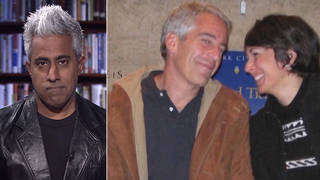
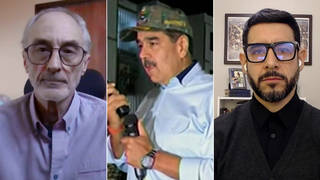
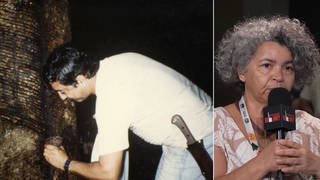
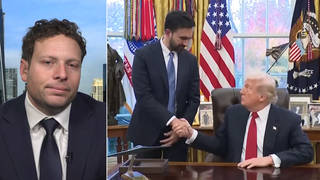





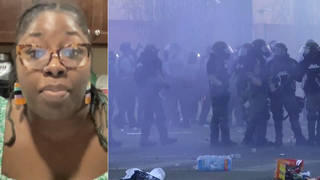

Media Options